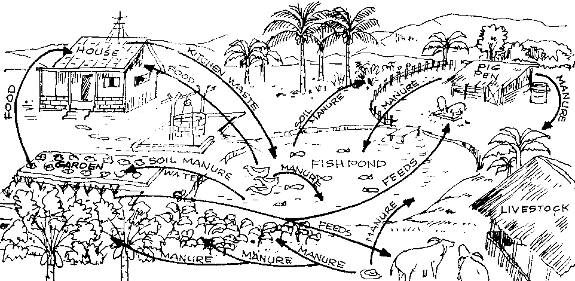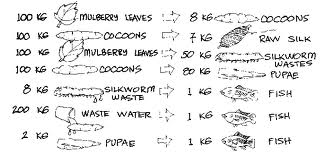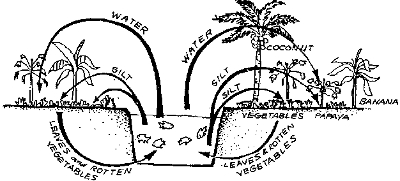
Integrating fish into permaculture systems

My challenge to the
Walden-Effect hive mind is --- can we take the
elegance of an aquaponics system and reinvision it without the
unsustainable aspects?
Here are some options I'm considering:
 Follow the
lead of the Chinese.
I've read several tidbits about the way traditional Chinese agriculture
integrates fish into their agricultural systems. One system
involves silkworms eating mulberry leaves, fish being fed the sikworm
pupae after the silk is removed from the cocoons, and the fish waste
being dredged up to fertilize the mulberry trees. Humans get
money from the silk and food from the fish with no outside inputs.
Follow the
lead of the Chinese.
I've read several tidbits about the way traditional Chinese agriculture
integrates fish into their agricultural systems. One system
involves silkworms eating mulberry leaves, fish being fed the sikworm
pupae after the silk is removed from the cocoons, and the fish waste
being dredged up to fertilize the mulberry trees. Humans get
money from the silk and food from the fish with no outside inputs.
 Go back to basics. A simple pond full of
aquatic plants, snails, and insects can feed low populations of
fish. Then you could harvest the aquatic plants to turn into
compost or mulch for the garden and eat the fish (or feed them to your
chickens if you'd rather).
Go back to basics. A simple pond full of
aquatic plants, snails, and insects can feed low populations of
fish. Then you could harvest the aquatic plants to turn into
compost or mulch for the garden and eat the fish (or feed them to your
chickens if you'd rather).
Take
advantage of the water's thermal mass. If we ever built a passive
solar greenhouse,
we'd want to include tanks of water as thermal mass. Turn those
tanks into fish tanks, make an integrated ecosystem just like you would
in a pond, then scoop out water from time to time to water and lightly
fertilize plants in the greenhouse.
What kind of
fish-related permaculture systems have you seen or dreamed up that
require absolutely no electricity or commercial fish food?
| This post is part of our Aquaponic Gardening lunchtime series.
Read all of the entries: |
Want more in-depth information? Browse through our books.
Or explore more posts by date or by subject.
About us: Anna Hess and Mark Hamilton spent over a decade living self-sufficiently in the mountains of Virginia before moving north to start over from scratch in the foothills of Ohio. They've experimented with permaculture, no-till gardening, trailersteading, home-based microbusinesses and much more, writing about their adventures in both blogs and books.
Want to be notified when new comments are posted on this page? Click on the RSS button after you add a comment to subscribe to the comment feed, or simply check the box beside "email replies to me" while writing your comment.

If you flip this around, introducing permaculture to aquaponics couldn't you drastically reduce the amount of electricity needed to do aquaponics?
Wouldn't reducing the electricity & using a small solar setup make it sustainable? Granted, it wouldn't be as cheap as throwing seeds in dirt, but it would also grow food in the winter.
Hi Anna,
If you look at the beginnings of Sepp Holzer and Fukuoka and the various American Indian stories and other lore, I see the same pattern. Take what I have and optimize it with simple steps.
Observe what works well and further optimize. It seems to me that that is what you and Mark are doing.
If you have running water, make a flow path with ponds along the way.
Flat land seems to be a big problem in that it doesn't trap water and nutrients as well as terraces and Sepp's hugelcultur. It also doesn't provide dry places above the water level.
I personally like Sepp Holzer's and Bill Molison's ideas most but that is probably because I am the most familiar with them.
John
We just bought some land with a good spring, and I have been thinking of a small pond with aquatic veggies (lotus, cress, cattail, etc). "Perennial Vegetables" by Eric Toensmeier mentions lots of edible perennial aquatics.
Then I was thinking that we could feed composting worms to the fish, thus recycling our yard waste into yummy fish.
But all of that's in the ten-year plan...
Anna,
in the excellent example above I think that Black Soldier Fly larvae could easily be substituted for the silk worm. The black soldier fly larvae gives the added benefit of disposal of a large quantity and variety of bio-solid feedstock (kitchen waste, garden plant waste, livestock and human manure waste, meat and bone scraps, etc.). This of course assumes that an omnivorous, fish is used. Further, the larvae can be set up to self harvest into the fish pond. Beyond that with a little ingenuity a pedal powered pump (seen here on the mayapedal.org website: http://mayapedal.org/waterpump.pdf) could be used to pump the water into the grow beds and gravity could be used to return the water to the pond. With a little experimentation I'm sure that a similar livestock powered device could be used as well. If your like me living in the north keeping such a system going in the winter would be a challenge. I think that an earth sheltered greenhouse heated with a rocket mass stove might hold a good deal of potential. Alternatively, some sort of small scale bio-gas digester system hooked to a common open flame greenhouse heater could potentially provide fossil fuel free heat in the winter as well. This set up would have the added benefit of providing co2 supplementation for the plants.
I think there's two main advantages to aquaponics the way it's traditionally considered (as in Bernstein's book): you can grow fresh meat and veggies without any land, and you can do it year-round. If you've got space and/or a warm climate, I agree there's no real benefit to incur the extra electricity costs for pumping and lighting.
And as you noted, it makes the most sense if you can generate the fish food on-site. To that end, I second Brad's suggestion on Black Soldier Fly Larvae. They're an excellent source of protein for fish http://www.cals.ncsu.edu/waste_mgt/smithfield_projects/phase2report05/cd,web%20files/A2.pdf, but I'm sure your chickens wouldn't mind a few extra grubs either. One of the nice things about BSF larvae is that they're self-harvesting: you can design a system such that when they're full grown, the larvae climb over a ledge and fall into your fish pond like a herd of tiny lemmings. http://www.youtube.com/watch?v=ICtWvTqA974
One of the nice things about BSF larvae is that they're self-harvesting: you can design a system such that when they're full grown, the larvae climb over a ledge and fall into your fish pond like a herd of tiny lemmings. http://www.youtube.com/watch?v=ICtWvTqA974
Another interesting option I read about a while back in The Integral Urban House http://www.amazon.com/Integral-Urban-House-Reliant-Living/dp/1897408161 was to set your beehives so the entrance faces over a fish-rearing pond. Then when old bees take their last flight, they're likely to end up as fish food.
A few ideas of including water plants and fish have bumped around in my noggin for a while. The circulation seems like it would be very hard to do without an easily directed stream or a good windmill water pump.
I've heard of a man who collects roadkill and suspends it (in mesh bags) on wires across his fishponds. When he sees enough maggots on the meat (binoculars), he gives the wire a few hard shakes to knock them into the water. Certainly sounds gross, but free fish food nonetheless.
Lots of edge definitely helps with pond critter biomass production. A lot of people suggest making long 'fingers' of shore line that spray out from the pond like sunrays and only go about a foot deep. It gives more space for the fry to live when they are young, as well as lots of space for larvae, tadpoles, wiggly things and the like to breed.
If I could be graced with a large enough pond I would love to try to build chinampas. In most ways they seem like the 'traditional' aquaponics. I don't know how well they could clean the water, but the system works in harmony. Growing right on the water reduces the need to water and fertility builds up and is accessible on the pond floor.
Oh how I hope the building of a homestead will be as fun as the planning
P.S I've always wondered if you are legally able to terraform and build a pond on the floodplain. I know you probably don't want to bother with the hassle of machines and disturbing the system. Not to mention the risk of losing fertility or being subject to whatever comes downstream during flood seasons. I only ask because I would think a large pond could be built easily, but don't know what protection statuses floodplains might have in your area.
I've really enjoyed everyone's comments, even if I haven't been commenting back. A few quick replies:
Jason --- If you look at the chart at the top of this post, you'll see that pumps are the least of your energy worries since you need to keep the system going all year to get good results. On the other hand, one of our readers commented on that post to mention a test project that does use electricity only for a pump --- I'll be waiting to hear how that system does as it goes into year two.
Brad and Jake --- We got really excited about black soldier fly larvae for our chickens when we first found out about them. Unfortunately, BSFs need a lot of food scraps, and we don't have many. We tried to get the food going to waste at our local elementary school, but soon learned it was illegal to do anything except compost it. BSFs might count as composting, but since they're only active in warm weather, that would leave us with a lot of food scraps we can't use in the winter. Until we end up with a lot more food waste that matches up only with the summer months, black soldier fly larvae don't seem viable for us.
Matthew --- Interesting ideas! To answer your question, I'm not sure about legalities of a pond in our floodplain, but I don't think it would be a good idea if we're trying to raise fish. The whole floodplain goes underwater a few times a year, and I suspect all of our hard-won fish would then escape. That's why if we ever do build ponds, they'll be up higher!